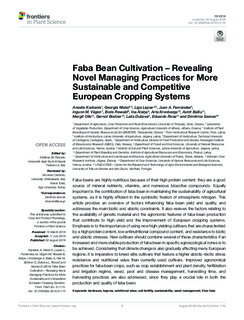| dc.contributor.author | Karkanis, Anestis | |
| dc.contributor.author | Ntatsi, Georgia | |
| dc.contributor.author | Lepse, Liga | |
| dc.contributor.author | Fernández, Juan A. | |
| dc.contributor.author | Vågen, Ingunn Molund | |
| dc.contributor.author | Rewald, Boris | |
| dc.contributor.author | Alsina, Ina | |
| dc.contributor.author | Kronberga, Arta | |
| dc.contributor.author | Balliu, Astrit | |
| dc.contributor.author | Olle, Margit | |
| dc.contributor.author | Bodner, Gernot | |
| dc.contributor.author | Dubova, Laila | |
| dc.contributor.author | Rosa, Eduardo | |
| dc.contributor.author | Savvas, Dimitrios | |
| dc.date.accessioned | 2018-08-06T12:20:15Z | |
| dc.date.available | 2018-08-06T12:20:15Z | |
| dc.date.created | 2018-08-03T16:30:46Z | |
| dc.date.issued | 2018-08-02 | |
| dc.identifier.citation | Frontiers in Plant Science. 2018, 9 1-14. | nb_NO |
| dc.identifier.issn | 1664-462X | |
| dc.identifier.uri | http://hdl.handle.net/11250/2507638 | |
| dc.description.abstract | Faba beans are highly nutritious because of their high protein content: they are a good source of mineral nutrients, vitamins, and numerous bioactive compounds. Equally important is the contribution of faba bean in maintaining the sustainability of agricultural systems, as it is highly efficient in the symbiotic fixation of atmospheric nitrogen. This article provides an overview of factors influencing faba bean yield and quality, and addresses the main biotic and abiotic constraints. It also reviews the factors relating to the availability of genetic material and the agronomic features of faba bean production that contribute to high yield and the improvement of European cropping systems. Emphasis is to the importance of using new high-yielding cultivars that are characterized by a high protein content, low antinutritional compound content, and resistance to biotic and abiotic stresses. New cultivars should combine several of these characteristics if an increased and more stable production of faba bean in specific agroecological zones is to be achieved. Considering that climate change is also gradually affecting many European regions, it is imperative to breed elite cultivars that feature a higher abiotic–biotic stress resistance and nutritional value than currently used cultivars. Improved agronomical practices for faba bean crops, such as crop establishment and plant density, fertilization and irrigation regime, weed, pest and disease management, harvesting time, and harvesting practices are also addressed, since they play a crucial role in both the production and quality of faba bean. | nb_NO |
| dc.language.iso | eng | nb_NO |
| dc.publisher | Frontiers Media S.A | nb_NO |
| dc.rights | Navngivelse 4.0 Internasjonal | * |
| dc.rights.uri | http://creativecommons.org/licenses/by/4.0/deed.no | * |
| dc.subject | landraces | nb_NO |
| dc.subject | legume | nb_NO |
| dc.subject | nutritional value | nb_NO |
| dc.subject | soil fertility | nb_NO |
| dc.subject | sustainability | nb_NO |
| dc.subject | weed management | nb_NO |
| dc.subject | Vicia faba | nb_NO |
| dc.title | Faba Bean Cultivation – Revealing Novel Managing Practices for More Sustainable and Competitive European Cropping Systems | nb_NO |
| dc.type | Journal article | nb_NO |
| dc.type | Peer reviewed | nb_NO |
| dc.description.version | publishedVersion | nb_NO |
| dc.rights.holder | © 2018 Karkanis, Ntatsi, Lepse, Fernández, Vågen, Rewald, Alsiņa, Kronberga, Balliu, Olle, Bodner, Dubova, Rosa and Savvas. | nb_NO |
| dc.source.pagenumber | 1-14 | nb_NO |
| dc.source.volume | 9 | nb_NO |
| dc.source.journal | Frontiers in Plant Science | nb_NO |
| dc.identifier.doi | 10.3389/fpls.2018.01115 | |
| dc.identifier.cristin | 1599716 | |
| dc.relation.project | EC/FP7/613781 | nb_NO |
| cristin.ispublished | true | |
| cristin.fulltext | original | |
| cristin.qualitycode | 1 | |

